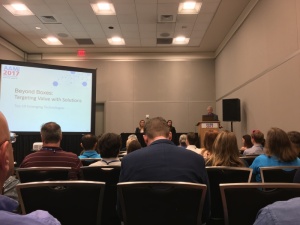Three emerging technologies biomeds should keep on their radar: AAMI
por
Lauren Dubinsky, Senior Reporter | June 13, 2017

James Laskaris speaking at the session
MD Buyline analysts captivated a packed room of biomedical engineers at the AAMI annual meeting on Sunday with a presentation on the top emerging technologies.
“When you sit in a capital budget meeting, you always hear those topics about how medical technology is the reason for the exorbitant rate of health care costs,” said James Laskaris, senior emerging technology analyst at MD Buyline. “One thing you really have to consider is that technology drives virtually all diagnoses and therapies out there.”
He went on to explain that the evolving health care environment is changing the way a technology’s return on investment is calculated. Hospitals are recognizing that when they invest upfront in a specific piece of technology, they can lower costs elsewhere.
“We are also looking at quality, value and cost savings,” said Laskaris. “Now quality is being financially incentivized by CMS, so it makes a big difference.”
3-D bioprinting
One of the most notable technologies discussed was 3-D bioprinting. Current technology allows scientists to grow biological cells in a lab and transplant them into the patient, but this new technology allows physicians to print structures such as skin tissue, heart, bone, muscle and lung.
The process involves liquefying cells from a patient or donor and then depositing them layer by layer on a scaffold based on the patient’s custom configuration. The cells then incubate until they become viable tissue.
“Major organs are years away, like the heart, but what we’re really focusing on are pretty simple structures for repair parts,” said Jessica Everitt, analyst at MD Buyline. “The idea would be to repair an existing structure with the patient’s own tissue rather than them having to have a donor organ.”
The 3-D printers cost around $100,000 and the liquefying agent costs $1,000 per 100 cc. There are many vendors in this space, and these devices will hopefully hit the market in the next few years, according to Everitt.
A kidney, liver and heart transplant can cost $150,000, $250,000 and $860,000 respectively, not including the cost of lifetime drug therapy. The benefit of 3-D bioprinting is that it’s a less costly procedure and involves lower long-term costs.
Nanobots
Another rapidly growing trend is nanotechnology and more specifically, nanobots. These robots are one billionth of a meter and can be used to treat cancer and certain infections.
“Currently it’s estimated to be a one trillion dollar business in the U.S. only,” said Lidia Chelkowska, clinical analyst at MD Buyline.
|
|
|
You Must Be Logged In To Post A Comment
|
